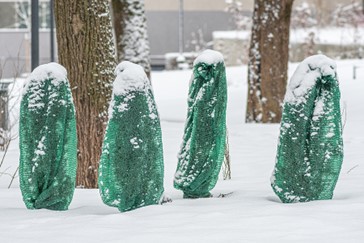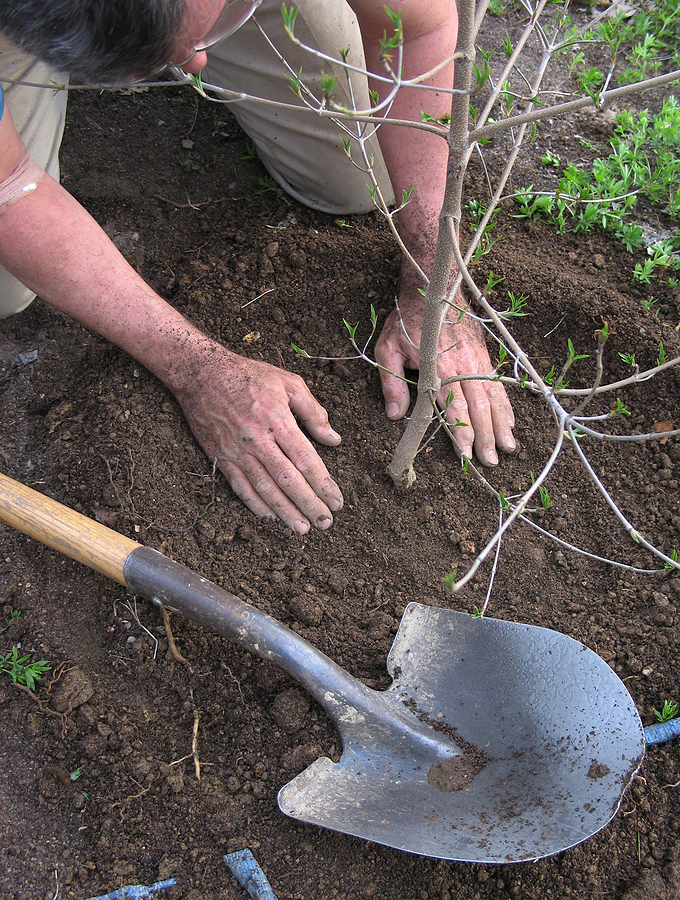Protecting Trees in Winter

Winter is a season of extremes in the Pacific Northwest, and on occasion, wreaks havoc on the trees that call the area home. However, there are many things one can do to protect trees in winter.
The main concerns winter brings for trees are uninvited, gnawing pests, dry, non-insulated soils, and damage from snow and high/dry winds.
Young and newly planted trees are the most susceptible to winter damage and need the most help though mature trees can and do fall prey as well. Avoid these problems by pruning, mulching, and guarding.
Prune in Winter
A reason for pruning in the winter is due to prevent snow/wind damage. Though the scene of snow resting atop tree branches is beautiful, it poses real-life risks. The weight of snow can be heavy on branches and poses the risk of falling limbs or uprooting entire trees, causing harm to the tree and possible structural damage to buildings or physical harm to passersby.
The trees most susceptible to snow damage are those with multiple leaders (more than one lead trunk), clump-forming trees, and upright evergreens. Heavy, dry winds pose a similar threat of falling branches, so removing risky branches sooner can avoid issues later if high winds are in the forecast.

An important part of tree protection in winter is pruning. Pruning is strongly dependent on the type(s) of trees (deciduous, evergreen, fruiting, ornamental) and the purpose of the pruning. Remember that pruning in the winter will encourage vigorous new growth in the spring, so plan accordingly.
Structural pruning can help shape the tree by selecting a central leader and removing dead, damaged, and dangerous (risky, susceptible to falling or “failure”) branches. It can be done on mature trees to limit falling branches, and strongly recommended for young trees to encourage stronger branching and reduce the need for heavy pruning in the future.
Winter Watering
The same snow that is bad for the branches above is much needed for the soil below to help keep the soil moist and protected from drying winds. Do one’s part by keeping soil well watered throughout the season, as moist soil helps to insulate roots better and receive more water than dry soil, which makes water penetration difficult if frozen. Be sure watering is thorough and deep enough to penetrate the root zone, ranging from 12”-18”.
Mulching Matters
Mulching is another way to help the soil around your trees. Mulching is an important tool to help insulate the roots and helps prevent the soil from drying or freezing completely, which can damage the tree through uprooting from alternating freeze/thaw cycles through the season.
Uprooting poses the risk of exposing tender roots to harsh winter sun and drying winds, while frozen soil prevents trees from replacing water after moisture loss from evaporation and transpiration. The temperature of the soil is higher than that of the temperature of the surrounding air.
Provide a protective barrier from the wind with 4”-6” of bark mulch, straw, or better yet, the leaves of the trees to act as mulch. Be sure the mulch is at least 6” away from the base of the tree, no mulch volcanoes! It can lead to rot if left to soak and discourages rodents from nesting by or eating the trunk.
Apply Tree Guards
As for guarding trees, winter is when food is scarce for wildlife, and young tender trees and the bark of mature ones are excellent sources of food. Though to the dismay of the gardener who admires said tree. Apply tree guards of plastic or wire around the tree at least 8” away from the tree to deter deer as best as one can.

Applying burlap or ¼” hardware cloth (not plastic) around the tree to at least 18” above the anticipated snow line can protect the tree from direct contact with snow, soaking the bark and creating fractures.
Wrapping trees with burlap can help prevent sunscald or frost cracks. Sunscald is when on warmer winter days, one side of the tree, typically the Southwest side, receives unusually warmer temperatures than the rest of the tree. When temperatures drop back to freezing at night, it can cause the tree’s cells to erupt. Frost cracks similarly occur on trees with darker-colored bark. When they receive bright winter sun exposure, which warms them up, they cool quickly at night, causing cracks from frozen water inside the cells.
We love to care for your trees and give you tips for protecting trees in winter. Give us a call at 360-574-4125.



